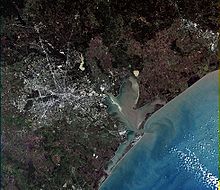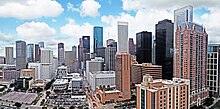East Texas
This article needs additional citations for verification. (January 2009) |

East Texas is a distinct geographic and ecological area in the U.S. state of Texas.
According to the Handbook of Texas, the East Texas area "may be separated from the rest of Texas roughly by a line extending from the Red River in north central Lamar County southwestward to east central Limestone County and then southeastward to Galveston Bay", though some separate the Gulf Coast area into a separate region.
This area includes all or parts of 49 counties, totaling almost 40,000 square miles (100,000 km2) and a population of almost 6 million. Another popular, somewhat simpler, definition defines East Texas as the region between Interstate 45 as the western border linking Dallas and Houston, the Louisiana border as the eastern border, the Oklahoma border as the northern border, and Galveston Bay shores as the southern border.
Most of the region consists of the Piney Woods ecoregion, and East Texas can sometimes be reduced to include only the Piney Woods. Houston is rarely regarded as a part of East Texas and is more closely associated with the Coastal Bend along the Gulf of Mexico; as has been the case for most of the city's recent history. At the fringes, towards Central Texas, the forests expand outward toward sparser trees and eventually into open plains.
Geography

Climate is the unifying factor in the region's geography—all of east Texas has the humid subtropical climate typical of the Southeast, occasionally interrupted by intrusions of cold air from the north. East Texas receives more rainfall, 35 to 60 inches (890 to 1,520 mm), than the rest of Texas.[1] In Houston the average January temperature is 50.4 °F (10.2 °C) and the average July temperature is 82.6 °F (28.1 °C), however Houston has slightly warmer winters than most of East Texas due to its proximity to the coast.
All of East Texas also lies within the Gulf Coastal Plain, but with less uniformity than the climate with rolling hills in the north and flat coastal plains in the south. Local vegetation also varies from north to south with the lower third consisting of the temperate grassland extending from South Texas to South Louisiana. The upper two-thirds of the region dominated by temperate forest known as the Piney Woods, which extends over 23,500 square miles (61,000 km2). The Piney Woods are part of a much larger region of pine-hardwood forest that extends into Louisiana, Arkansas, and Oklahoma. The Piney Woods thins out as it nears the Gulf of Mexico. West of the Piney Woods are the ranchlands and remnant oak forests of the East Central Texas forests ecoregion.


The Sabine River and Trinity River are the major rivers in East Texas, but the Brazos River and Red River also flow through the region. The Brazos cuts through the southwest portion of the region while the Red River forms its northern border with Oklahoma and a portion of Arkansas. In East Texas and the rest of the South, small rivers and creeks collect into swamps called "Bayous" and merge with the surrounding forest. Bald cypress and Spanish moss are the dominant plants in bayous. The most famous of these bayous are Cypress Bayou and Buffalo Bayou. Cypress Bayou surrounds the Big, Little, and Black Cypress rivers around Jefferson. They flow east into Caddo Lake and the adjoining wetlands cover the rim and islands of the lake.
Outside of the Greater Houston area the average population density is around 18–45 per mi² (7–12 per km²), with the population density near the Big Thicket dropping below 18 people per mi². East Texas's population is centered around Beaumont/Port Arthur/Orange in Southeast Texas, Lufkin/Nacogdoches in Deep East Texas, and Tyler, Longview/Marshall, and Texarkana in Northeast Texas. At its western edge, East Texas overlaps with Central and North Texas; so cities like Corsicana, and Greenville may be included in liberal definitions of East Texas. Only eight miles from the Texas border, Shreveport, Louisiana, is considered the economic and cultural center for the Ark-La-Tex, the area where Arkansas, Louisiana, and East Texas meet.
Culture

East Texas is often considered the westernmost extension of the Deep South, and is culturally more connected to the Lower South states than the other regions of Texas. The Museum of East Texas was opened in Lufkin in 1976 under the name the Lufkin Historical and Creative Arts Center.[2]
Deep East Texas
Deep East Texas is a subregion of East Texas. According to the Deep East Texas Council of Governments the region consists of the following twelve counties: Angelina, Houston, Jasper, Nacogdoches, Newton, Polk, Sabine, San Augustine, San Jacinto, Shelby, Trinity, and Tyler.
The "Deep" designation comes from the similarity to East Texas (it is similar in culture and geography, being highly forested), but with a location "deeper" (i.e., further east and away from the Gulf coast) than the rest of East Texas.
"Deep" also refers to the cultural and social characteristics of the area and is considered synonymous to "The Big Thicket", an allusion to the dense growth of underbrush in the "piney woods." It was the earliest area of Texas to be settled by Anglo-Americans (and one of the last to submit to law enforcement—by the governments of Spain, Mexico, the Republic of Texas, state of Texas or the United States). Renegade clans controlled local governments, especially in Shelby County, well into the first quarter of the 20th century.[citation needed]
The area contains two of the oldest towns in Texas; Nacogdoches, the oldest town in Texas, dating from 18th century, and San Augustine, the oldest "Anglo" settlement in Texas, dating from the 1820s. People of English, Scottish, Scots-Irish and to a lesser extent Welsh ancestry predominate in the region, which is in contrast to West Texas in which people of German and Hispanic heritage predominate. Prior to the Texas War of Independence, settlement was generally prohibited by the Spanish and later Mexican governments, but neither government was able to exert control or law enforcement in the area. As a consequence, the "Big Thicket" became a refuge for criminals fleeing the United States and hiding out in a "no man's land" in the pine thickets.
Economy
In the decades leading to 2009, crude oil production in the East Texas Oil Field, the largest oil field in the United States, decreased. In turn, the number of high-paying jobs for uneducated workers also decreased. Many small towns had closed cafés and gas stations, some of which were replaced with cash loan shops and pawn shops.[3]
Paul Knight of the Houston Press in a 2009 article that "some say [natural gas] has surpassed crude as king in East Texas."[4]
See also
References
- ^ "Weather." Handbook of Texas. Retrieved on September 28, 2009
- ^ "Museum of East Texas". Handbook of Texas Online. Retrieved 2007-02-07.
- ^ Knight, Paul. "Superthief." September 22, 2009. 1. Retrieved on September 28, 2009.
- ^ Knight, Paul. "Superthief." September 22, 2009. 2. Retrieved on September 28, 2009.
Books
- CHINQUA WHERE? The Spirit of Rural America, 1947-1955, ISBN 978-0972965507 by Fred B. McKinley.
- Black Gold to Bluegrass: From the Oil Fields of Texas to Spindletop Farm of Kentucky, ISBN 157168946X by Fred B. McKinley and Greg Riley.
- Gone to Texas: Genealogical Abstracts from The Telegraph and Texas Register 1835-1841, compiled by Kevin Ladd.
- The EAST TEXAS SUNDAY DRIVE Book, by Bob Bowman ISBN 1-878096-00-1.
- Wild Flowers of the Big Thicket, East Texas, and Western Louisiana, by Geyata Ajilvsgi ISBN 0-89096-065-8.
- Two centuries in East Texas: A history of San Augustine County and surrounding territory from 1685 (Hardcover)by George Louis Crocket (Author)ASIN: B00089CVW8.
External links
- East Texas from the Handbook of Texas Online
- East Texas Historical Association
- Sights of Interest in East Texas
- 1840 Map of East Texas From Texas Tides
- Texas Heritage Society
